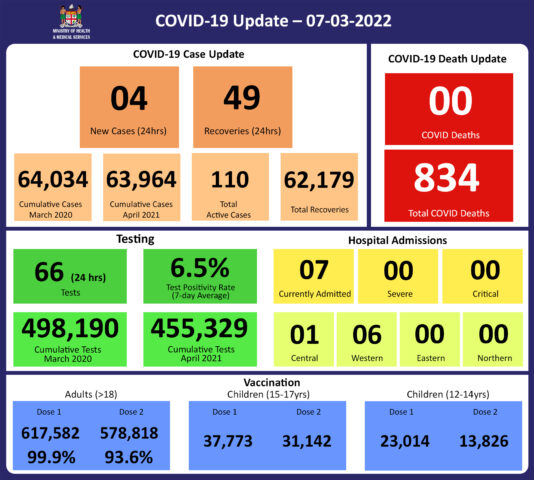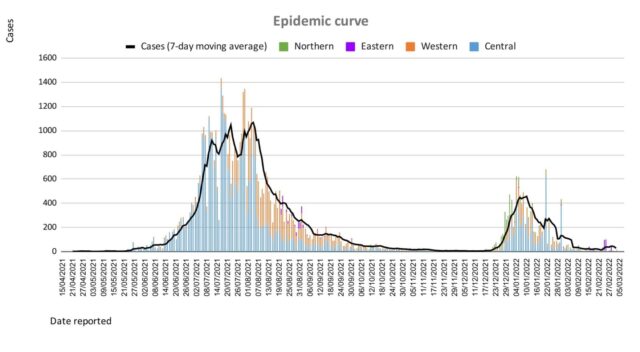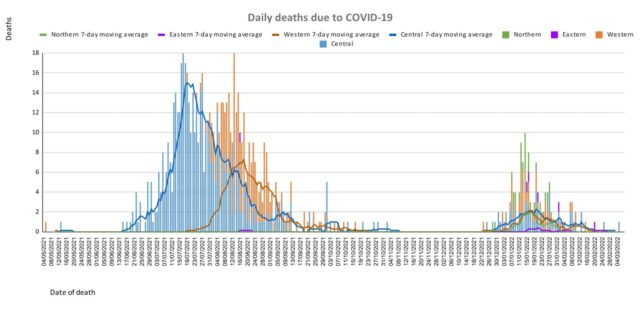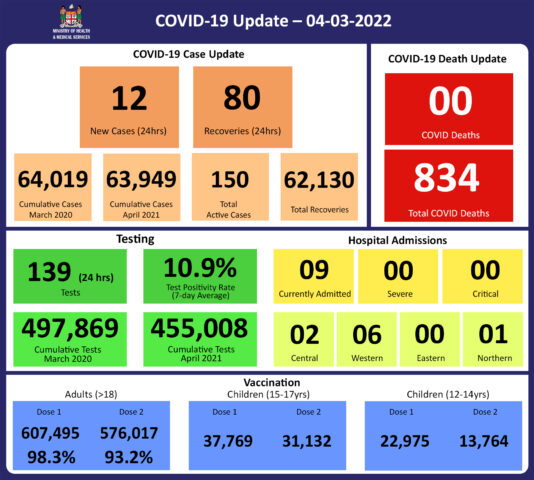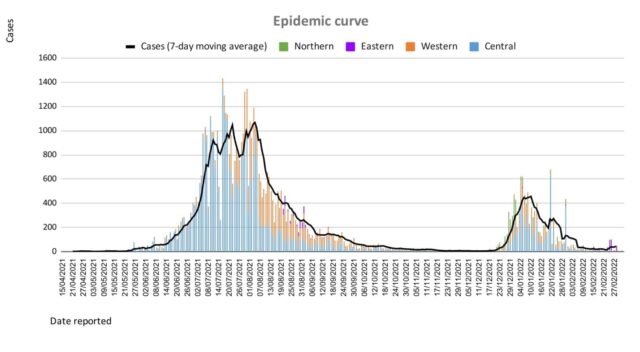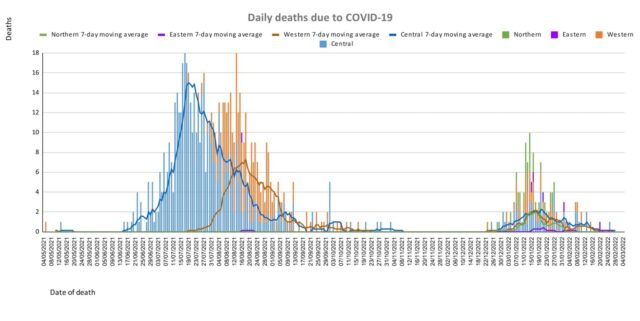COVID-19 Situation Update
Wednesday 09th March
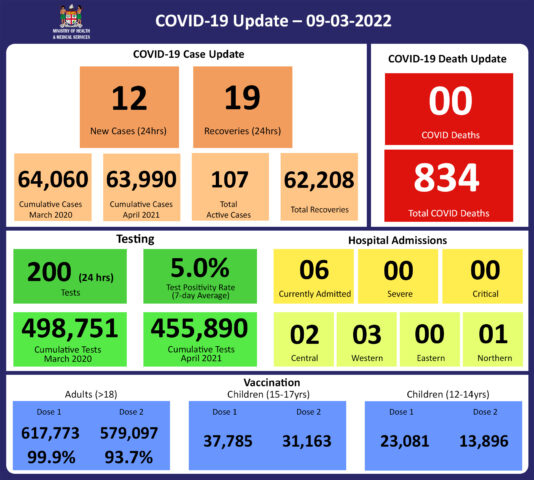
| Transmission Update:
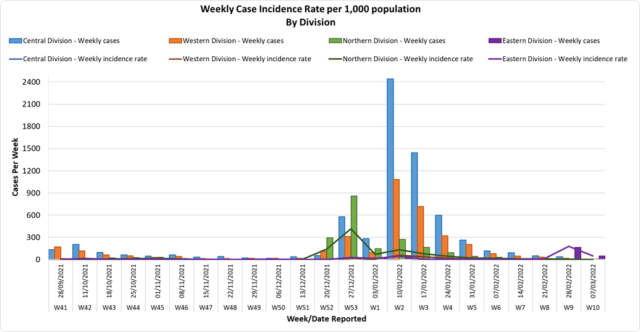
Since the last update, we have recorded 26 new cases of which 14 new cases were recorded on 08/03/2022 and 12 new cases in the last 24 hours ending at 8 am this morning.
Of the 26 cases recorded, 17 cases were recorded in the Central Division; 5 cases were recorded in the Western Division, 3 cases were recorded in the Northern Division, and 1 case was recorded in the Eastern Division.
The national 7-day rolling average of cases as of 5th March is 14 daily cases.
In the 7 days until 08/03/2022, 25 new cases were recorded in the Central division, 15 new cases in the Western division, 5 new cases in the Northern Division, and nil new cases in the Eastern Division.
The Central Division cases constitute 68% of the cumulative total cases nationally, with the Western division making up 27%, 3% in the Northern Division, and 2% in the Eastern Division. |
Deaths:
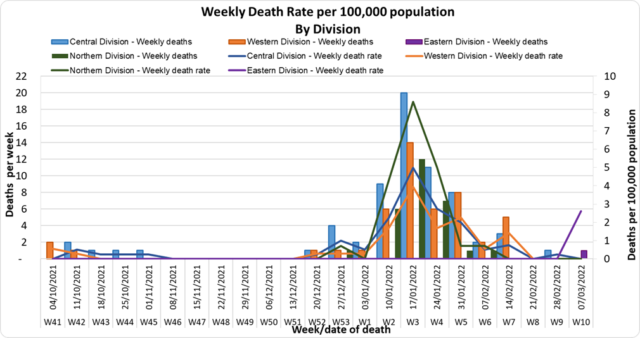 The curves depict weekly COVID-19 deaths by division since May 2021. It indicates a surge from December-end 2021, which peaks by mid-January 2022. The 3rd COVID 19 wave is considered to have started around mid to late December 2021. (Note: Death notifications from within the last two weeks are still being received, therefore the graphs may alter slightly upon reporting). The curves depict weekly COVID-19 deaths by division since May 2021. It indicates a surge from December-end 2021, which peaks by mid-January 2022. The 3rd COVID 19 wave is considered to have started around mid to late December 2021. (Note: Death notifications from within the last two weeks are still being received, therefore the graphs may alter slightly upon reporting).
Analysis of Deaths in the Third Wave
Table 1: Death rates by Division
| Division |
Total COVID Deaths |
Deaths per 100,000 |
| Central |
61 |
15.4 |
| Western |
44 |
12.3 |
| Northern |
28 |
20.0 |
| Eastern |
5 |
13.0 |
An analysis of the 138 deaths recorded in the third wave shows that, while the Central Division has the highest absolute number of deaths, the Northern Division has the highest rate of death when adjusted for population.
Table 2: Deaths by Age Group
| Age Group |
Total Deaths |
Deaths per
100,000 population |
| 0 – 9 |
6 |
3.3 |
| 10-19 |
2 |
1.3 |
| 20-29 |
3 |
2.1 |
| 30-39 |
4 |
2.9 |
| 40-49 |
6 |
5.4 |
| 50-59 |
18 |
19.8 |
| 60-69 |
27 |
51.9 |
| 70-79 |
42 |
187.5 |
| 80-89 |
23 |
408.8 |
| 90-99 |
5 |
961.5 |
For the 138 deaths in the third wave, the death rate adjusted per 100,000 population, has been highest in age groups 50 and onwards. There were 8 deaths below the age of 19 years, 7 out of the 8 children had significant pre-existing medical conditions, and one child had no known underlying medical condition.
Table 3: Deaths by Vaccination Status
| Age Cohort |
Total COVID deaths |
Total Vaccinated/ Unvaccinated |
Deaths per 100,000 Vaccinated Population |
Deaths per 100,000 Unvaccinated Population |
| >18 |
129 |
55/75 |
9.4 |
175.4 |
| 15-17 |
1 |
0/1 |
0 |
6.6 |
| 12-14 |
1 |
0/1 |
0 |
2.5 |
Out of 138 COVID -19 deaths reported in the third wave, six (6) deaths were in the population not eligible for vaccination (under age 12). An analysis of the 133 deaths in the vaccine-eligible population reflected, that when adjusted per 100,000 population, for fully vaccinated (received 2 doses) and unvaccinated/not fully vaccinated (received 0 doses or only 1 dose) adults in Fiji, a death rate of 9.6 per 100,000 population for fully vaccinated adults and 190.5 for unvaccinated adults was exhibited. This means that unvaccinated adults in Fiji have been dying at a rate 18.5 times higher than fully vaccinated adults during the current COVID-19 wave. Individuals of the 12-17 age group who died were not vaccinated. There have been no COVID-19 deaths in individuals who received a booster (3rd dose) of the vaccine.
New deaths to report
There is no new COVID-19 death to report.
There have been a total of 834 deaths due to COVID-19 in Fiji. Please note that due to the time required by clinical teams to investigate, classify and report deaths, a 4-day interval is given to calculate the 7 days rolling average of deaths, based on the date of death, to help ensure the data collected is complete before the average is reported. Therefore, as of March 05th, 2022, the national 7 days rolling average for COVID-19 deaths per day is now 0.0, with a case fatality rate of 1.29%.
We have recorded 909 COVID-19 positive patients who died from other serious medical conditions unrelated to COVID-19; their doctors determined that COVID-19 did not contribute to their deaths, therefore these are not classified as COVID-19 deaths. |
| Hospitalization:
There is a sustained downward trend in daily hospitalizations. Using the WHO clinical severity classification, a greater percentage, 50% (n=3) of the admissions of COVID-19 positive patients are categorised as asymptomatic and mild, 17% (n=1) is categorised as moderate and 33% (n=2) as severe with nil cases in the critical category. Anyone admitted to the hospital is tested before admission, therefore, a significant number of people are admitted to the hospital for non-covid health conditions, but incidentally, test positive due to the high amount of transmission in the community. The number of people being admitted because of COVID-19 remains low. |
| Testing:
200 tests have been reported for March 8th, 2022. Total cumulative tests since 2020 are 498,751 tests. The 7-day daily test average is 170 tests per day or 0.2 tests per 1,000 population.
The national 7-day average daily test positivity is 5.0%. The positivity rate is an indication of widespread community transmission. |
Public Advisory:
LTDD Response update
As previously mentioned, the recent weather has resulted in conditions conducive to outbreaks of leptospirosis, typhoid, and dengue fever, which are climate-sensitive diseases endemic to Fiji. We are also aware of the recent weather reports predicting increasing rainfall over the next few days, and as such the medical advice we provide needs to be followed, while we continue to mount our public health and clinical response. We have especially noted increasing leptospirosis cases, hospitalisations, and deaths following similar weather events. Please heed our advice to protect yourselves and your loved ones.
The outreach efforts in Rakiraki continue with FEMAT support. Four teams consisting of one medical officer, one nurse, and one health inspector were deployed to different medical areas. Their objectives were to;
- Reach out to all the villages in the Ra sub-division within 2 weeks.
- Actively look for and treat patients with suspected LTDD.
- Create awareness for all the villages in the Ra sub-division on LTDDs.
The main impact of the FEMAT deployment is that we have had a bigger increase in the suspected line list for LTDD, however, home medical treatment and follow-up capability resulted in only 6 admissions and no deaths within a very short time. This impact was experienced despite ongoing weather conditions. Also while the number of cases continues to occur at outbreak levels in the Rakiraki Medical Area, the exercise facilitated early treatment which resulted in decreased severity and duration of the disease in those put on the line list. The active pursuit of cases, however, cannot be sustained over a long time, and as such community engagement to promote better health-seeking behaviour remains the priority means of facilitating early treatment and support.
The FEMAT team will be wrapping up services this week for a much-needed break.
Leptospirosis
There have been 991 confirmed cases of leptospirosis this year, with 279 new cases in the last week. Outbreaks are ongoing in all four divisions.
In the Central Division, there have been 336 cases, with 102 in the last week.
In the Western Division, there have been 390 cases, with 99 in the last week.
In the Northern Division, there have been 245 cases, with 72 in the last week.
In the Eastern Division, there have been 20 cases, with 6 in the last week.
For hospital admissions so far this year there have been:
- 179 admissions in the West, with 19 new admissions last week, indicating a downward trend in admissions. New admission were from Ra, Nadi, Ba, Tavua, Lautoka, and Nadroga/Navosa.
- 113 admissions in Central, with 19 new admissions in the last week, indicating a downward trend in admissions. The majority of admissions were in Vunidawa.
- 38 admissions in the Northern Division, with 9 new admissions last week (2 from Taveuni, and 7 in Macuata), indicating a slight upward trend compared to the 7 admissions in the previous week.
- 10 admissions in the Eastern Division, with 5 in the last week, indicating an upward trend compared to 0 admissions in the previous week. The admissions have been from Levuka, Kadavu, and Lomaloma.
Sadly, there have been 2 more deaths caused by leptospirosis reported since the last update on 02/03/22: a 19-year-old from Taveuni, and a 24-year-old from Macuata. There have been a total of 25 deaths from leptospirosis this year, with 18 in the Western Division, 2 in Central, and 5 in the North.
While we have seen cases in all age groups. Cases remain predominantly in the 10-39-year-old age group, with more in males than females, and in people of the i-Taukei ethnicity.
Prevention
The leptospirosis bacteria is spread to humans through the urine of infected animals, such as cows, pigs, rats, and dogs. To reduce your individual risk, it is important to understand that exposure to animals, soil, mud, and floodwaters during work or recreational activities increases your risk of infection.
Important prevention measures include wearing full covered footwear at all times when going outdoors, avoiding wading or swimming in flooded waters, using clean fresh water to wash up after exposure to muddy waters, and keeping all food and drinks covered and away from rats. For workplaces, practice good personal hygiene at all times, cover cuts and wounds well, and use protective equipment, especially footwear when in flooded and/or muddy areas.
We are also urging all parents and guardians to prevent children from playing in the mud or swimming in flooded rivers or creeks, and ensure that they wear shoes when outside.
Symptoms and treatment
Early treatment can decrease the severity and duration of the disease. Please seek medical care if you have recently had contact with floodwaters, mud, or animals, and develop the following symptoms: fever, muscle pain, headache. You may also have red eyes, loss of appetite, nausea/vomiting, dizziness, or feel weak.
Leptospirosis can be treated with appropriate antibiotic medications prescribed by a doctor if treatment is sought early. Danger signs for severe leptospirosis include shortness of breath, coughing blood, chest pain, yellow eyes/skin (jaundice), signs of bleeding (including unexplained bruising), decreased or increased urination, difficulty staying awake. Severe leptospirosis is life-threatening, and anyone with these symptoms must be taken to the hospital immediately.
Typhoid fever
There have been 53 cases of typhoid fever this year, with 7 in the last week (6 from West and 1 from North) Nationally typhoid cases are within the number expected for this time of the year. However, there are localized outbreaks in communities in Ra, Lautoka, and Nadi. Sadly, there have been 5 deaths from typhoid fever this year: an 18-year-old, a 45-year-old, and a 22-year-old from Ra; a 51-year-old from Lautoka; and a 1-year-old from Lautoka.
Typhoid fever is typically found in areas that do not have access to proper toilet facilities and/or clean drinking water. We strongly encourage people who live in rural areas, informal urban areas, and any other areas where access to clean drinking water is limited, to boil all drinking water. We must all also continue to practise basic hygiene measures such as frequently washing hands with soap and water, especially after visiting the toilet and before eating or preparing food.
Dengue fever
There have been 965 confirmed cases of dengue fever so far this year, with 245 cases in the last week. There are outbreaks in the Western Division (Nadi, Tavua, Ba) and the Eastern Division (Levuka).
We continue to urge everyone to get rid of potential mosquito breeding places, such as empty containers inside and outside your homes that may collect water, including discarded tires, flower vases, and pot plant bases. Protect yourself from being bitten by mosquitoes by using mosquito screens in your homes, and mosquito repellants.
COVID-19 Vaccination
As of the 09th March, a total of 108,369 individuals have so far received booster doses. Members of the public are advised to obtain their booster dose after at least 5 months from their second COVID-19 vaccine dose. Moderna vaccine and Pfizer vaccines are both available for adult booster doses.
The Ministry of Health and Medical Services will continue to monitor the advisories on post-infection immunity based on quality data that is being generated globally
Given the current stocks of Pfizer Vaccine we have we will be using Pfizer for the ongoing primary 2 dose schedule of children and adults and as the booster dose.
Supporting International Travel
- Plan to remove 3-day hotel stay for fully vaccinated travellers from Travel Partner Countries.
Since the opening of international travel borders to travel partner countries travellers coming in from Travel Partner Countries have had to undergo an in-country test in Fiji on day 2 of stay in Fiji. To support this requirement, a 3-day hotel stay was mandated to minimize the risk of non-compliance to testing and to ensure that all positive tests were appropriately responded to while the traveller was locatable. To be clear, this 3-day stay in a Care Fiji Commitment (CFC) hotel was never a quarantine. The hotel stay is in place to facilitate the testing requirement on day 2 of arrival.
We have noted that while many countries have removed all forms of traveller sequestration, the in-country testing conditions continue. As such we are supporting current efforts to have more testing sites throughout Fiji to which travellers can book for testing, without requiring a hotel stay, as part of prior approval to come into Fiji. We are working together with the Ministry of Trade and Tourism and Ministry of Economy in the final phase of approving this in-country testing for international arrivals by private entities. These private entities will ensure that the test is available and the results will be reported back to Ministry of Health officials. They will also be mandated to report any international traveller who defaults from the mandatory testing. Any traveller defaulting a test will be subject to legal punitive measures.
- Ongoing Review of Non-Travel Partner Country Status
This ongoing effort is mediated through the Ministry of Commerce, Trade, Tourism and Transport, and the Ministry of Economy (COVID-19 Risk Mitigation Taskforce). Non-Travel Partner Status is assessed and graduated to Travel Partner status based on COVID-19 Transmission Data (cases, admission, and deaths), COVID-19 Community Surveillance data (Test per 1000, positivity rate), and ability to detect Variants (Access to genomic sequence capability). A list of Travel partner countries is available on the following link: https://www.mcttt.gov.fj/home/traveltofiji/international-travel/#b




